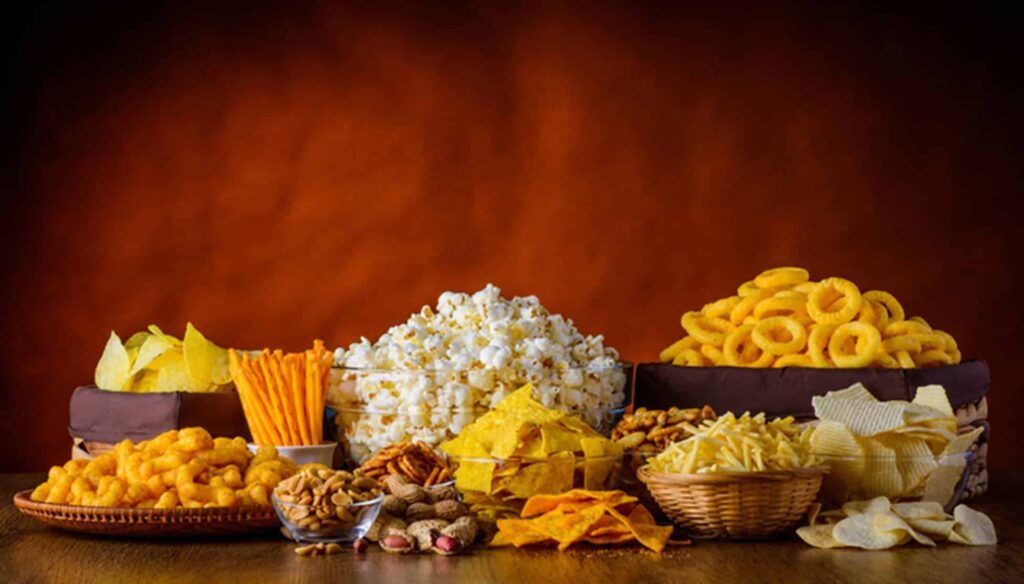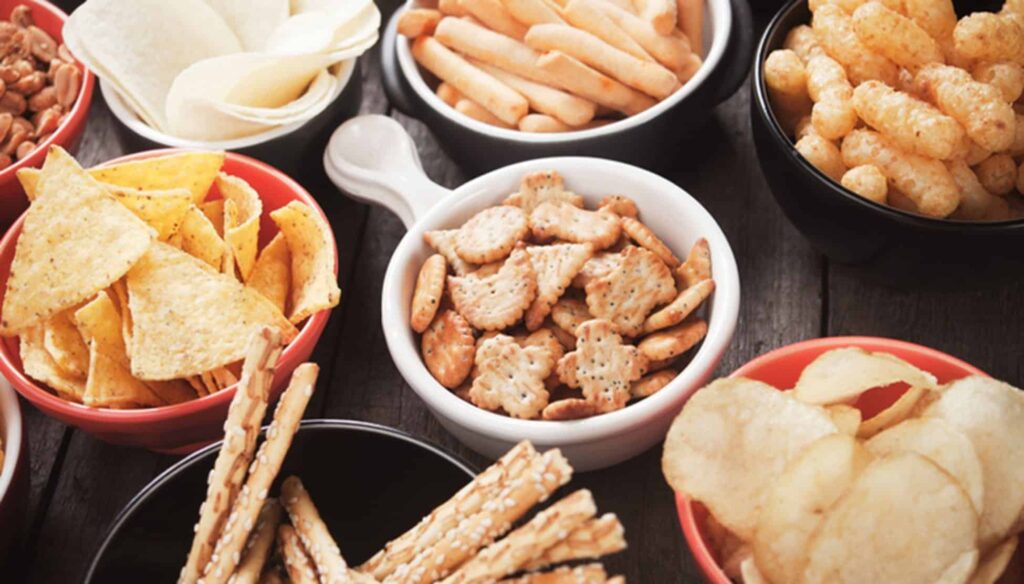Snacking has evolved from simple fruit and nut portions to a diverse world of processed delights. But what are the different kinds of snack foods? In this exploration, we delve into the rich history and varieties of snack foods. We’ll also discover the essential role played by advanced industrial conveyor systems in the efficient and precise manufacturing of these delectable treats.
What Are the Different Kinds of Snack Foods?
Snack foods encompass a wide array of delightful options, ranging from savory classics like pretzels, salted peanuts, and potato chips to sweet indulgences such as candies, chocolates, and baked treats. Trail mixes, popcorn, and exotic snacks like the Indian Namkeen mixture also contribute to the diverse world of snacks. Each type offers a unique flavor profile, satisfying cravings for both the salty and the sweet, making snack time a flavorful journey.

Unveiling the Evolution of Snack Foods
Snack food encompasses any conveniently prepared, ready-to-eat cuisine, eliminating the need for extensive preparation. Throughout history, individuals have opted for small portions of fruits, vegetables, or nuts between meals, replenishing their energy and curbing hunger. The landscape of snacking underwent a transformative shift in the 19th century with the introduction of processed, packaged snacks.
In contemporary times, snacks have emerged as a pivotal component of daily diets, appreciated for their delectable tastes and ease of consumption. The accelerated pace of modern living has compelled individuals to explore alternatives to traditional meals, leading them to embrace snacks as a readily available and socially acceptable dietary choice, suitable for breakfast, lunch, or dinner.
The Categorization of Snack Foods by Generation and Processing Techniques
Snack food constitutes a diverse category, with individuals often classifying snacks based on various factors. Beyond the primary distinction between sweet and savory snacks, people also categorize them according to the applied food processing techniques. The initial generation comprises items like peanuts, nuts, or dried fruit snacks.
However, savory options, including corn chips, puffed corn products, balls, and curls crafted from extruded materials, typically fall into the second generation of snacks. Recognized for being high in fiber and protein and low in calories, these second-generation products represent a healthier snack choice. The third generation of snacks pertains to fried and flavored snacks created from extruded pellets.

Variety of Processed Snack Foods
Exploring the expansive realm of processed snack foods unveils a tantalizing array of flavors and textures that have become integral to our snacking rituals. Let’s go through the variety of processed snack foods, discovering the nuances that make each treat a delightful and satisfying experience.
Salty Snacks – Flavor Dynamics and Convenience Innovations
More than half of snack sales contribute to the considerable presence of salty snacks in the contemporary consumer diet. The surge in the salty snack market is primarily fueled by evolving flavor preferences and convenience considerations. Robust and intense flavors continue to be a major trend in salty snacks, complemented by convenience factors that shape both the form and packaging of processed salty treats.
The salty processed snack market is composed of the following segments:
- Pretzels
Pretzels are a popular baked snack twisted into a knot-like shape and are crafted from a dough comprising brown sugar, wheat flour, yeast, and water. Before baking, they undergo a unique process, being immersed in a solution of sodium bicarbonate, sodium carbonate, or sodium hydroxide and then generously sprinkled with coarse salt. The distinctive flavor and brown hue emerge during the baking phase.
Introduced to the snack market in the early 20th century, pretzels gained prominence with the advent of automated production. “Rold Gold,” established as the “American No. 1 Pretzel” brand in 1917, has evolved into a family business that expanded nationwide. Presently, Rold Gold pretzels are recognized as lactose-free, predominantly baked snacks.
- Salted Peanuts
Salted peanuts, among the earliest processed snack foods, trace their origins back to the late 19th century when they were sold as freshly roasted treats at circuses, fairs, and sporting events. The classic salted-in-the-shell variety remains popular, while consumers also appreciate salted peanuts infused with new flavors.
- Potato Chips
Potato chips, a favorite snack for 63% of participants in the United States, generate an annual retail sales revenue of $4 billion, alongside pretzels. Originally sold in barrels on the streets, their freshness posed a challenge until the revolutionary invention of the vacuum sealing technique, contributing to the snack food industry’s advancement.
Recent additions to the snack market include apple chips and banana chips, catering to those seeking healthier chip alternatives. Although unsalted potato chips are available, the consumer preference predominantly leans towards the savory, salty chip variety.
- Popcorn
Popcorn, derived from popping corn, is a corn type that bursts from the kernel when heated, forming its characteristic shape. Naturally low in fat and calories, sugar-free, high in fiber, and free from sodium, popcorn is an ideal snack choice unless limiting carbohydrates is a dietary consideration.
- Trail mix
Trail mix is a mix of various types of nuts (particularly those rich in Omega-3 fatty acids), cashews, walnuts, pecans, almonds, dried fruit, etc. Also, they may contain granola, breakfast cereals, pretzels, chocolate chips, carob chips, shredded coconut, and seeds. Trail mix is also known as student food. It’s considered brain food due to the combination of healthy fats, fiber, and protein that provide a sustained energy boost. It’s easy to store, affordable, and easy to prepare and eat on the go.
- Indian Namkeen mixture
Ready to Eat Namkeen is a South Indian snack food that’s having a major moment in the US. They are typically made of salty sev, whole wheat flour, rice flour, carom and sesame seeds, and dried fruits, with the addition of various spices and red chili peppers. Very popular for its taste, there is a large demand in overseas markets – the export market is growing at around 20% annually and is estimated at $33.4 million.
Sweet Snacks Beyond Tradition – Unveiling Unique Categories and Historical Triumphs
Categorically, sweet snacks are segmented into four distinct groups: hard candy, chocolates, baked products, and frozen sweets. Interestingly, the initial triumph in the American market for sweet snacks did not align with any of these conventional categories. Specifically, “Cracker Jack” emerged as a delectable confection featuring a blend of peanuts and popcorn intricately combined with molasses.
- Candy
Candy typically denotes sugar confectionery, created by dissolving sugar in water or milk to form a concentrated syrup, to which various flavorings can be added. Hard candy exhibits a diverse range of textures, encompassing both brittle and chewy varieties. Examples of candies sold under this collective term include rock candy, gumdrops, jelly beans, toffee, praline, caramel, fudge, peppermint sticks, candy canes, peanut brittle, chocolate-coated peanuts or raisins, and various types of hard candy.
Notably, hard candy treats like lemon drops and peppermints originated as homemade delicacies in 18th-century Europe. The 19th and 20th centuries witnessed the surge in popularity of such sweet snacks in America, introducing a plethora of unique hard candies to the market. Pioneering brands like “Saltwater Taffy” and “Life Savers” emerged as early leaders in the realm of hard candy in the United States.
- Chocolate
Chocolate encompasses a range of processed snack foods derived from the seeds or beans of the cacao tree. Due to their profoundly bitter taste, the seeds undergo a fermentation process. Post-fermentation, the seeds are subjected to drying, cleaning, and roasting. The removal of the seed’s shell yields cacao nibs, which are then ground and liquefied. This process results in chocolate liquor, a form of pure liquid chocolate.
The liquor can undergo further processing to yield either cocoa butter or cocoa solids. Pure chocolate primarily consists of varying proportions of cocoa butter and cocoa solids. The chocolate we commonly consume today is predominantly a blend of pure chocolate and sugar
- Baked Sweets
Baked sweet snacks typically incorporate a combination of butter, flour, eggs, baking powder, and shortening. These treats often feature pastry with a butter-rich dough, evenly distributed before the baking process to achieve a flaky and light texture. Key variations of pastry dough include Choux Pastry, Puff Pastry, Flaky Pastry, Phyllo, Sweet Crust, and Shortcrust. The enduring tradition of pastry consumption, coupled with a high rate of innovation, maintains consistent consumer interest, ensuring robust and sustained sales.
Among America’s preferred baked snacks are cookies and crackers. The term “cookie,” originating from Dutch, initially referred to sugar cookies with diverse spices available in grocery stores. Noteworthy early commercial cookie brands include “Animal Crackers” and “Fig Newtons,” emerging in the late 19th century. Today, the iconic sandwich cookie “Oreo” holds worldwide acclaim, boasting an annual production of 40 billion units.
Preserving Snack Quality – The Crucial Role of Tubular Conveyor Systems
When it comes to the transport of snack materials during processing, product damage caused by using the wrong snack food conveyor system is a huge concern for snack manufacturers. Tubular cable and disc conveyors that gently move the material throughout the facility during processing have proven to be the most effective. They keep the processing plant clean and minimize breakage and attrition. With minimized imperfections and breakage, snack food manufacturers avoid producing low-quality snacks, product loss, and diminished value of their products.
Efficient Blending and Maintenance Precision With Cablevey Conveyors
The importance of maintaining the original blend cannot be overstated – once the new snack food product is tested and approved, manufacturers must maintain the exact blend from day one. The main components of most snacks are flour, sugar, and fat, and what makes the distinction between products are blends and technologies/equipment used.
Consistency is key, and Cablevey Conveyors helps maintain the blends that are so carefully designed and implemented. Our tubular drag cable conveyors are more efficient when compared to alternatives, such as bucket elevators (that toss materials), pneumatic conveyors (that blow materials), and screw augers (that escalate materials within a screw).

Choose One of the Most Reliable Conveyor Systems Manufacturers on the Market
An added level of care is required to ensure that cross-contamination is avoided throughout the manufacturing process, particularly from the surrounding environment, personnel, or the processing equipment. This is where tubular drag conveyors come into play because they are enclosed, protecting the product from contaminants. Cablevey’s automated conveyor systems are clean, using air knives, urethane disks, and brushes to mitigate the accumulation of fines and breakage, ensuring the integrity and quality of any snack product. For almost 50 years, Cablevey has supported various food manufacturers with its unique, customizable, and versatile line of tubular cable and disc conveyor systems. Contact us today, and we’ll start creating a tailored solution for your facilities right away.






